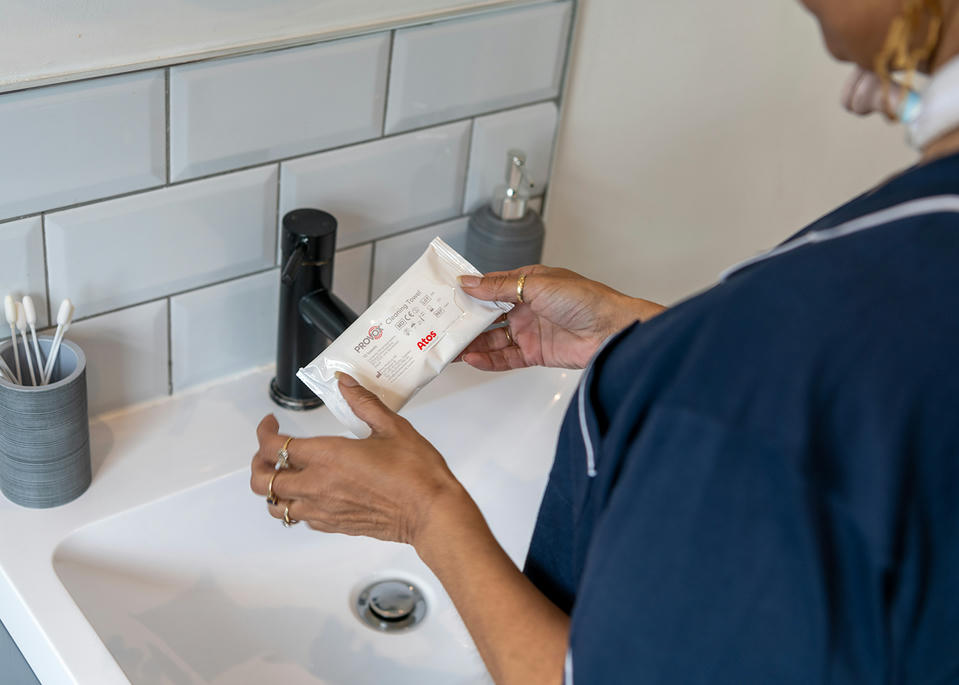Caring for My Skin and Stoma

Providing attentive care to the stoma and surrounding skin is essential for reducing the risk of irritation, infection, and skin breakdown which can adversely affect your health and recovery. This page provides a guide on stoma and skin care and details the products commonly utilized for this purpose.

Skin Health
Taking care of the skin around your tracheostomy site is an important part of your daily routine. Skin can be irritated by mucus, moisture, dressings, medications, pressure from the tube, or treatments like radiation therapy. Damaged skin is more vulnerable to infections and can be painful and difficult to treat.
Keeping your skin clean and dry is crucial to reduce the risk of infection, irritation, and skin breakdown. Follow your healthcare team's instructions on which supplies to use, how to clean, and how often, as these will depend on your condition, tracheostomy incision, and type of tube.
Skin Care Measures
1. Encourage hand hygiene
Encourage hand hygiene: Reduce infection risk by washing hands before and after skin care or handling the tracheostomy tube.

2. Maintain clean and dry skin
Clean your skin with the recommended agent such as drinkable water, sterile water, saline, mild soap, or a disposable cleansing towel. Use moistened swabs or gauze pads to remove dried mucus and clean hard to reach areas like under the neck flange, neck band, or at the stoma site. Pat the area dry with a gauze pad, clean washcloth, or let it air dry. Skin barrier wipes or creams can be applied after cleaning to add a protective layer on the skin. Clean the skin regularly, which in general is daily, or more often based on your skin condition and mucus production.
3. Inspect for any changes:
Check the skin around your tracheostoma, including under the tube, neck flange, ties, neckbands, or dressings. Use a large mirror with good lighting or a handheld mirror for hard to see areas like the back of your neck. A caregiver can assist in monitoring. Report any skin changes or concerns to your healthcare team.
4. Change dressings
Change dressings as advised by your healthcare provider or manufacturer, generally once or twice daily or when contaminated, wet, or saturated with body fluids. Remove wet or saturated dressings promptly to reduce skin breakdown.
5. Follow skin treatment guidance
For skin treatments, use moisturizers to prevent dryness or prescribed creams for irritation or wound healing as advised. Avoid irritants or getting powders or creams on the tracheostomy tube or in the stoma, and only use those recommended by your medical team.
6. Secure your tube
Secure the tracheostomy tube properly with a neckband to minimize tube movement which can exert pressure on the skin, potentially causing areas of breakdown.
7. Manage secretions
Mucus or moisture on the skin can cause irritation, which may lead to breakdown and infection. Remove mucus promptly. Manage secretions with suctioning or coughing, maintain humidification with devices such as an HME, use inhaled medications as directed, and continue following the treatment plan to address the underlying cause.
8. Seek medical attention
Detecting skin issues early allows for prompt treatment. Report signs of infection or skin breakdown to your healthcare provider, such as increased redness, swelling, warmth, pain, hardening of the skin, open sores, wounds, a foul smell, or unusual drainage from the tracheostomy site.
Tracheostomy Care Tips
How-to videos that provide you with detailed instructions on using and managing our devices through a step-by-step approach.
Dressings

Tracheostomy dressings are used around the tracheostoma to manage skin care. Dressings come in various shapes, sizes, and materials like gauze and foam, or with additives such as hydrocolloid, silicone, or aluminum coating. The choice depends on your skin condition, mucus production, and personal preference. Your healthcare team will advise which dressing to use and how to perform skin care and dressing changes. Regularly changing the dressing is a routine part of tracheostomy care and is often combined with skin care measures.
Purposes of tracheostomy dressings
Mucus absorption
Dressings are intended to absorb moisture, mucus, and other secretions from the stoma site. This helps maintain cleanliness and dryness of the skin surrounding the stoma.
Skin protection
Exposure to moisture, mucus, or friction from the tube or neck flange rubbing on the skin can cause irritation or breakdown. Dressings can act as a protective barrier to reduce the risk of developing sores or pressure ulcers that may result from this.
Tube security
Certain tracheostomy dressings assist in securing the tube to prevent accidental displacement or frequent movement.
Comfort
Some dressings provide extra cushioning and can reduce friction, pressure, and irritation at the tracheostomy site which may feel more comfortable.
Types of Tracheostomy Dressings
Basic dressing
Gauze dressings are commonly used and come in various thicknesses, shapes, and sizes for padding around the stoma and absorbing secretions.

Foam dressing
A thicker dressing is often used for advanced skin care needs, like excessive mucus or irritated skin. The foam absorbs heavy secretions, preventing leakage and maintaining skin integrity.

Aluminium coated dressing
A specialized type of dressing featuring an aluminum-coated side that provides a shiny, smooth surface. This design is adherent yet minimizes sticking to the skin or wound, helping to maintain healthy tissue.

Learn more:
Getting Started with an HME
The importance of wearing an HME to take care of your pulmonary health after a tracheostomy procedure and a clear guidance how to start using it.
Learn more
Lung health
The basics of the pulmonary function and how to keep healthy your respiratory system.
Learn more
Tracheostomy tubes
Comprehensive Overview of the Components and Functions of a Tracheostomy Tube.
Learn more
Eating and drinking
Valuable information about the impact of tracheostomy on eating and drinking functions and some useful tips
Learn more
Speaking with a tracheostomy
The loss of speech following a tracheostomy can be both challenging and isolating. However Recovery of vocal function is still possible.
Learn more
References
- Alsunaid S, Holden VK, Kohli A, Diaz J, O’Meara LB. Wound care management: tracheostomy and gastrostomy. J Thorac Dis. 2021 Aug;13(8):5297-5313.
- Bryant R. Types of skin damage and differential diagnosis. In: Mosby E, editor. Acute & Chronic Wounds: Current Management Concepts. 4th ed. 2012. p. 83-107.
- LeBlanc K, Baranoski S; Skin Tear Consensus Panel Members. Skin tears: state of the science: consensus statements for the prevention, prediction, assessment, and treatment of skin tears©. Adv Skin Wound Care. 2011 Sep;24(9 Suppl):2-15.
PM36933_202502




